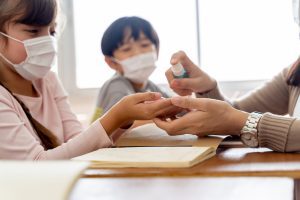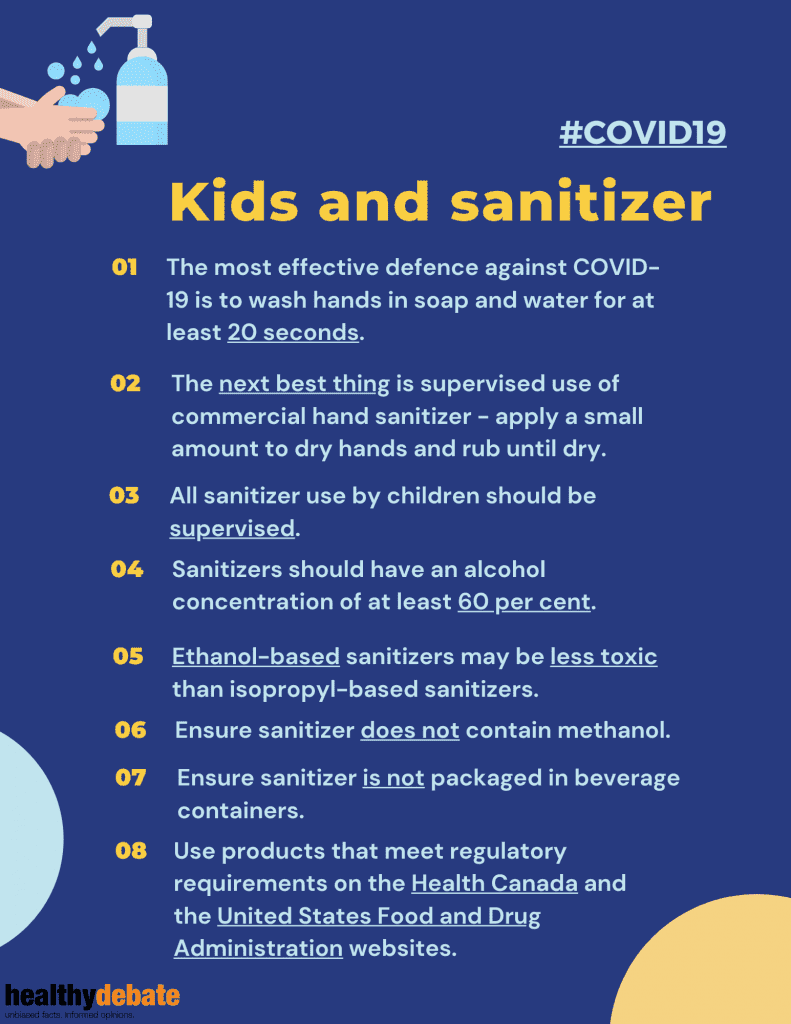As if parents don’t already have enough to worry about with their children returning to school amidst a pandemic and the flu season around the corner, it turns out that the new household staple that keeps their kids safe may also be harmful – hand sanitizers.
As parents continue to stock up on this gel-like substance, experts caution that it needs to be used and stored very carefully.
Increasing numbers of young children are accidentally ingesting sanitizers that can be poisonous because of their high alcohol content. Significant sanitizer exposure can result in eye irritation and vomiting and far more serious consequences such as seizures and the inability to breathe.
Reports from the National Poison Data System in the United States show a staggering 46 per cent increase in the average number of daily calls to poison control centres about sanitizer exposure in children 12 years and younger this past March compared with March 2019.
In Canada, the Drug and Poison Information Centre at the B.C. Centre for Disease Control also reported a significant increase in sanitizer exposure in children under 5, with calls in April tripling to seven a week from January and February, when they averaged fewer than two a week.
Dr. Sarah Khan, a pediatric infectious disease specialist at McMaster Children’s Hospital in Hamilton, stresses that the risk should not deter parents from using sanitizers, which are an effective alternative when soap and water are unavailable. If supervised and used effectively, there should be a very low risk of ingestion.
“Alcohol evaporates quickly from hands so it should not remain in large quantities on hands for children to ingest,” says Khan. “The key is that sanitizers should be rubbed in until hands are completely dry.”
In fact, Khan worries about another consequence not widely discussed – the potential to develop dermatitis, a skin condition that can be debilitating.
Cases of irritant contact dermatitis (ICD) have increased since the start of the pandemic, which some dermatologists say is related to the increase in handwashing. With repeated exposure to the chemicals found in soaps and sanitizers, the outer layer of the skin can become damaged, causing small breaks in the skin. The itchy skin often appears dry, inflamed and cracked.
For many, this is a small price to pay for protection against the raging viruses – but it is important to monitor for signs of secondary infection that can happen with any break in the skin. To prevent ICD, parents should look for soaps and sanitizers that have emollients in them. Children should also be encouraged to apply moisturizer to their hands throughout the day and especially immediately after handwashing.
Amid sanitizer recalls, toxicity risk reports and a lack of access to sanitizers on store shelves, some parents have taken to making sanitizer at home. Queries of “DIY sanitizer” in a popular search engine went up by 60 per cent last February and March.
A recent study analyzed the 100 most-viewed do-it-yourself sanitizer videos on YouTube and concluded that most videos were in direct violation of recommendations from the World Health Organization (WHO). Eighty-two per cent of them failed to describe the need to label sanitizer containers, 69 per cent encouraged the use of oils or perfumes and 2 per cent promoted the use of colouring agents, all of which make it more likely for a child to be exposed to or accidentally ingest the solution.
Not only were these videos – with an average of 699,807 views – encouraging ways to make sanitizers more attractive to children, many recommendations were also ineffective. Only 27 per cent of analyzed videos discussed the importance of using an alcohol base of at least 96 per cent ethanol or 99.8 per cent isopropyl alcohol.
“I would not be confident about how effective homemade hand sanitizer is,” Khan says. “If concerned about sanitizers, soap and water is the best option.”
Faced with shelves full of varying brands and packaging, some parents also face confusion and indecision when purchasing hand sanitizers.
“I usually look for the sanitizer with the highest alcohol percentage,” says Sohela Lazar of Hamilton, a mother of children aged 1, 5 and 7. “There isn’t enough guidance on which type of alcohol is more effective or less harmful to kids so my choice is not based on that.”
Lazar is right – most recommendations don’t distinguish between ethanol-based and isopropyl-based sanitizers. Dr. Martha Fulford, an infectious disease specialist in Hamilton, says ethanol-based sanitizers are the better choice for younger children as they are less toxic. Consumers should check the ingredients listed on the back of sanitizer bottles.
Health Canada has also warned about the risk of poisoning from hand sanitizers sold in beverage containers; children are more likely to mistake sanitizers for something to drink when sanitizers are stored in such packaging.
A further concern is the proliferation of counterfeit hand sanitizers. On Oct. 20, Health Canada recalled a counterfeit hand sanitizer sold at some Dollarama stores, the most recent of its more than 100 recalls.
Experts say the safest way to protect children from COVID-19 is to wash their hands with soap and water. This is especially true for children less than 4 years old because toddlers are more likely to touch their mouths with their hands. Lazar says that she only uses soap and water for her youngest child. “Like any toddler, he sticks his hands into his mouth, which I get nervous about,” she says.
As for babies, they are “exceedingly unlikely to be spreading infection,” says Fulford. “The concern is more with people touching the baby. They should be diligent about washing their own hands before interacting with the newborn.”
As an added precaution, toxicologist Dr. Howard An of St. Joseph’s Health Centre in Toronto emphasizes the importance of properly storing sanitizer. “We always recommend that any chemicals in the home should be locked up tight and out of sight, preferably in a medical cabinet that children cannot access,” says An.
The best advice boils down to what our parents taught us: Wash your hands often. “At a minimum, hand hygiene should be practised before eating, after toileting, after touching mucus membranes or a mask and after touching highly contaminated objects such as door handles and elevator buttons,” says Khan.




The comments section is closed.
The biggest issue for my family is our kids had a sanitizer bottle in their bathroom and would push down for a whole pump each time. That is waaaay too much product for their little hands. I asked Purell on Twitter and they confirmed the same, see reply here: https://twitter.com/PURELL/status/1318164050606542850
To make sure they would get the safe / right amount we adjusted how far the pump can travel with these little clips. Worked super well and helped a lot. https://www.etsy.com/ca/listing/869487514/soapsavers-3-pack-fits-most-hand